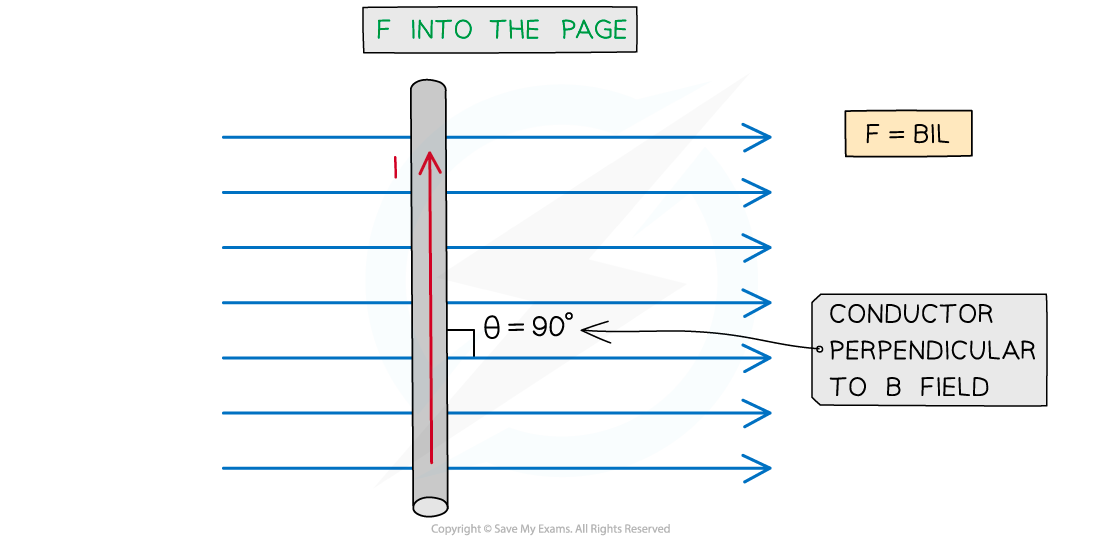Magnetic Force on a Current Carrying Conductor (WJEC GCSE Physics): Revision Note
Exam code: 3420
Magnetic Force on a Current Carrying Conductor
The Motor Effect
The motor effect occurs when:
A wire with current flowing through it is placed in a magnetic field and experiences a force
This effect is a result of two interacting magnetic fields
One is produced around the wire due to the current flowing through it
The second is the magnetic field into which the wire is placed, for example, between two magnets
As a result of the interactions of the two magnetic fields, the wire will experience a force
Magnetic Fields Interacting

The magnetic field between opposite poles of magnets interact with the magnetic field produced around a current-carrying wire
Force on a current-carrying wire in a magnetic field

The motor effect is a result of two magnetic fields interacting to produce a force on the wire
Factors Affecting Force
The size of the force exerted by the magnetic fields can be increased by:
Increasing the amount of current flowing through the wire
This will increase the magnetic field around the wire
Using stronger magnets
This will increase the magnetic field between the poles of the magnet
Placing the wire at 90o to the direction of the magnetic field lines between the poles of the magnet
This will result in the maximum interaction between the two magnetic fields
Note: If the external magnetic field and wire are parallel there will be no interaction between the two magnetic fields and therefore no force produced
Examiner Tips and Tricks
It is key to remember that the magnetic force on the conductor is maximum when current is perpendicular to the field lines. The force is zero when current and the external field are parallel.
Fleming's Left Hand Rule
The direction of the force (aka the thrust) on a current carrying wire depends on the direction of the current and the direction of the magnetic field
All three will be perpendicular to each other
This means that sometimes the force could be into and out of the page (in 3D)
The direction of the force (or thrust) can be worked out by using Fleming's left-hand rule:
Fleming's left-hand rule

Fleming's left-hand rule can be used to determine directions of the force, magnetic field and current
Use Fleming’s left-hand rule to show that if the current-carrying wire is placed into the magnetic field between the poles of the magnet, as shown below, there will be a downwards force acting on the wire.
Current into the plane of the page

Align your fingers with the diagram to use Fleming's left-hand rule
Step 1: Determine the direction of the magnetic field
Start by pointing your First Finger in the direction of the (magnetic) Field.
Step 2: Determine the direction of the current
Now rotate your hand around the first finger so that the seCond finger points in the direction of the Current
Step 3: Determine the direction of the force
The THumb will now be pointing in the direction of the THrust (the force)
Therefore, this will be the direction in which the wire will move
Different orientation of the left-hand rule

You may have to move your hand around for different questions - this is fine as long as you remember which finger represents which quantity
Examiner Tips and Tricks
Remember that the magnetic field is always in the direction from North to South and current is always in the direction of a positive terminal to a negative terminal. Feel free to use Fleming's left hand rule in your exam, just don't make it too obvious or distracting for other students!
Calculating Magnetic Force on a Current-Carrying Conductor (HT only)
Higher Tier Only
The size of the force acting on a current-carrying wire in a magnetic field can be calculated using the equation:
Where:
F = force acting on current-carrying wire in Newtons (N)
B = magnetic flux density (which is the strength of the magnetic field) in Tesla (T)
I = current flowing through the conductor in Amps (A)
L = length of the conductor that is in the magnetic field in metres (m)
Force on a current-carrier perpendicular to a magnetic field

Force on this current carrying conductor is directed into the page
Worked Example
A 5 cm length of wire is at 90o to the direction of an external magnetic field. When current of 1.5 A flows through the wire it experiences a force of 0.06 N from the motor effect. Calculate the magnetic flux density of the magnet.
Answer:
Step 1: List the known quantities and convert length to m
Length, L = 5 cm = 0.05 m
Current, I = 1.5 A
Force, F = 0.06 N
Step 2: Write out the equation for force on a current-carrying conductor in a magnetic field
Step 3: Rearrange this for magnetic flux density, B
Step 4: Substitute the known quantities
Examiner Tips and Tricks
For the maximum force, F, then B and I must be perpendicular to each other. If the question states that the wire and field are parallel then F = 0!
Make sure that the units for F is Newtons, B is Tesla, I is Amps and L is metres. Convert any units if you're given otherwise (e.g. cm to m in the worked example.)

You've read 0 of your 5 free revision notes this week
Unlock more, it's free!
Did this page help you?